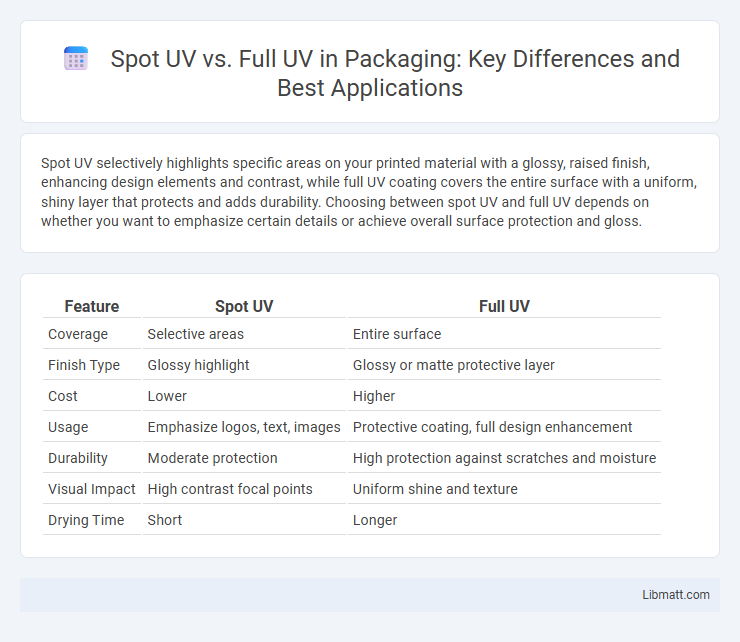Spot UV selectively highlights specific areas on your printed material with a glossy, raised finish, enhancing design elements and contrast, while full UV coating covers the entire surface with a uniform, shiny layer that protects and adds durability. Choosing between spot UV and full UV depends on whether you want to emphasize certain details or achieve overall surface protection and gloss.
Table of Comparison
| Feature | Spot UV | Full UV |
|---|---|---|
| Coverage | Selective areas | Entire surface |
| Finish Type | Glossy highlight | Glossy or matte protective layer |
| Cost | Lower | Higher |
| Usage | Emphasize logos, text, images | Protective coating, full design enhancement |
| Durability | Moderate protection | High protection against scratches and moisture |
| Visual Impact | High contrast focal points | Uniform shine and texture |
| Drying Time | Short | Longer |
Introduction to Spot UV and Full UV
Spot UV is a printing technique that applies a high-gloss coating selectively to specific areas of a printed piece, enhancing visual contrast and tactile experience. Full UV coating covers the entire surface of the print, providing a uniform glossy finish that protects the material and intensifies colors. Both methods utilize ultraviolet light to cure the coating quickly, ensuring durability and a professional appearance.
What is Spot UV Coating?
Spot UV coating is a specialized printing technique that applies a high-gloss, ultraviolet-resistant finish to specific areas of a printed piece, enhancing visual contrast and texture. This selective coating targets particular design elements, such as logos or images, to create a striking, tactile effect without coating the entire surface. Spot UV differs from full UV coating, which covers the entire print, by providing precise, localized shine and protection.
What is Full UV Coating?
Full UV coating is a clear, glossy finish applied to the entire surface of a printed piece, enhancing durability and providing a high-shine appearance. This coating protects against scratches, moisture, and fading, making it ideal for business cards, postcards, and packaging that require a premium look and long-lasting quality. You benefit from full UV coating when seeking to add a vibrant, eye-catching finish that ensures your printed materials stand out.
Key Differences Between Spot UV and Full UV
Spot UV selectively applies a glossy coating to specific areas of your design, creating contrast and highlighting particular elements, while full UV covers the entire surface uniformly, providing a consistent sheen and enhanced durability. Spot UV is ideal for emphasizing logos, text, or images, offering a tactile experience without overwhelming the overall design. Full UV is best suited for protecting the entire printed piece from wear and tear, making your materials more resistant to scratches, moisture, and fading.
Advantages of Spot UV Coating
Spot UV coating delivers a striking contrast by selectively applying a glossy finish to specific areas, enhancing visual appeal and drawing attention to key design elements. This targeted approach conserves resources compared to full UV coating, making it more cost-effective while maintaining durability and scratch resistance. Your printed materials benefit from a sophisticated look that highlights logos, images, or text, elevating brand perception without overwhelming the entire surface.
Benefits of Full UV Coating
Full UV coating offers superior protection by covering the entire surface with a durable, glossy layer that resists scratches, moisture, and fading, ensuring your printed materials maintain vibrant colors and a polished appearance over time. This coating enhances the tactile quality and visual impact, making your product stand out with a smooth, professional finish that attracts attention. You benefit from increased longevity and a premium look that elevates brand perception in marketing materials.
Best Uses for Spot UV vs Full UV
Spot UV is best used for highlighting specific design elements like logos, text, or images on printed materials, creating a glossy contrast that draws attention and adds a tactile dimension. Full UV coating provides a uniform protective layer across the entire surface, ideal for items that require durability and moisture resistance, such as menus, business cards, or packaging. Choosing the right finish depends on your design goals--opt for Spot UV to enhance particular features and Full UV for comprehensive protection and vibrancy.
Cost Comparison: Spot UV vs Full UV
Spot UV typically costs less than full UV coating due to the selective application on specific areas of a print, reducing the amount of coating material used and the labor involved. Full UV coating covers the entire surface, resulting in higher material costs and longer production time, which increases the overall price. Businesses often choose spot UV for budget-friendly enhancement of highlights, while full UV is preferred for premium, durable finishes that justify the higher expense.
Design Considerations for UV Coatings
Spot UV coatings apply a high-gloss finish selectively to specific areas of a design, enhancing visual contrast and emphasizing details without covering the entire surface. Full UV coatings provide a uniform, protective layer across the whole design, resulting in a consistent sheen and durability against wear and fading. Design considerations include the desired aesthetic impact, texture contrast, and budget constraints, as Spot UV can be more costly due to its precision application compared to the relatively economical full UV coating.
Choosing the Right UV Coating for Your Project
Choosing the right UV coating depends on your desired visual impact and budget; Spot UV highlights specific areas with a glossy finish to create contrast, while full UV covers the entire surface for uniform protection and shine. Spot UV is ideal for business cards, book covers, or promotional materials where emphasis on logos or text is needed, whereas full UV enhances durability on postcards, brochures, or packaging. Your project's purpose and aesthetic goals will guide whether the precision of Spot UV or the comprehensive coverage of full UV suits your needs best.
Spot UV vs full UV Infographic

 libmatt.com
libmatt.com